Strawberries
2012 Monterey Bay Academy Field Day Announcement
The 2012 Monterey Bay Academy Field Day is planned for this coming August 16 with registration starting at 8:30 am. Agenda items are are a general discussion of growing strawberries in substrate, fruit and foliar pathogens, lygus bug management, anaerobic soil disinfestation, use of steam and mustard meal as soil sterilants and the use of Zeus herbicide.
Please refer to the agenda attached below for further information:
http://cesantacruz.ucdavis.edu/files/147807.pdf
Closing in on an Answer on a Case of Yellow Strawberry Plants in Castroville.
Situation: The complaint we were invited to evaluate in this field was less typical than what one often finds with yellow plants in Salinas or Watsonville. These patches of yellow plants were typically dispersed in patches of various sizes in the field (photo 1 below), but on one side of the field this was particularly pronounced. This area corresponded with a farm road from a previous artichoke plantation as well as being the end of the drip tapes installed by the strawberry grower.
The bed tops tended to be dry and moisture has been adequate but not excessive, so my running thesis of excess water actually did not fit so well in this situation.
I had the good fortune on this particular call of being accompanied by Frank Shields from Soil Control Lab, who did a thorough evaluation of a bed and plant tissue (photo 2 below) and arrived at the results as depicted in photos 3 and 4 below.
Evaluation: As readers can assess from the attached analyses, this sampling was extraordinarily detailed. The soil analysis breaks down the bed into ten zones and evaluates no less than 14 parameters of each zone. Furthermore, in zone 7, Frank took a general sample of the soil texture and shrinkage, which gives an assessment of at what moisture percentage cracks form in the soil.
As a standard operating procedure, Frank sampled one bed containing symptomatic plants according to a pattern of ten different areas, the cross section of which can be seen in the soil report attached below. Additionally, Frank uprooted several plants for evaluation of the roots and tissue mineral contents in the foliage.
This soil test strives to accomplish a number of things. First, it is designed to monitor the movement and location of accumulated soluble salts for the purpose of determining the water pattern from the irrigation system. Similarly, since during the season strawberry fertilizer is supplemented via the water it is useful to know where the nutrients are ending in the bed to confirm that they are getting to the plant and not being leached out of range or being affected by adverse pH or salt conditions.
Plant available nutrients are both water soluble and exchangeable. This analysis is designed to monitor the water soluble fraction for the water soluble plant nutrients nitrate, nitrite, chloride, and sulfate as well as cations which accumulate with the water soluble fraction like calcium, potassium, sodium and ammonia.
Interpretation of Results:
Moisture: All zones were very wet indicating recent irrigation of sufficient volume to completely fill the bed and should leach salts and nutrients down and out of the bed. Additionally, there were no shrinkage cracks visible when observing the fifty foot section of row again indicating that the soil had been kept sufficiently moist.
The pH is on the high side and evenly distributed between 7.8 and 8.4 though all zones. However, this pH is not unusually high and normally would not be said to be problematic for strawberries.
Soil potassium is this sample low. It is typical for soils in Salinas and the Pajaro Valley to have potassium concentrations above 150 ppm, but with the exception of zone 10 of the bed this particular sample ranges around 50 ppm or below. This is reflected in the leaf potassium concentration of 0.9% when a range of 1.3 – 1.8% is ideal for this time of year.
Soil nitrate appears to be substantially leached out, and indeed the percentage in the leaves of the sampled yellow plants is 2.0%, which is somewhat less than the optimum of 2.4- 3.0 % for this time of year. Still, 2.0 % dry weight tissue nitrogen would not explain the substantial yellowing we observe in the field.
Phosphorous, calcium, magnesium and the other micronutrients appear to be sufficient according to the attached tissue analysis.
Nitrites, which are oxidized to plant available nitrate in the process of nitrification but toxic to plants in quantity are absent from the sample. This is quite probably because of the well aerated soil and lack of packing.
EC5: This is a measure of the amount of water soluble components in a zone. Zone six has the highest in the root zones (1 – 8) but all within values to support plant growth. With proper watering, salts should accumulate in zone six, nine and ten. In this sample, salt accumulation is highest at zone ten typical of a pattern of a bed having full mulch and plenty of water.
We can also look at the ratio of water soluble cations to get an idea on the ratio of plant available constituents like the SAR value and soluble Ca/Mg ratio. The very high sodium and chloride compared to the low calcium and magnesium in this sample is significant and indicates a problem. Indeed, sodium and chloride are excessively high in the plant tissue and very likely to be interfering with normal plant function.
Outside of the carbonates, the soil minerals are an accumulation both from the irrigation water and nutrients added to the soil. If most of the salts accumulated in the bed are naturally found in the irrigation water (as is the case here), it means that the nutrients are being leached out of the root zone with excess water and additional fertility could be considered.
Conclusion: Rather than being a problem of the deficiencies of nitrogen or potassium, Frank maintains that at issue here is a buildup in the affected areas of chloride and accumulated salts as a result of irrigation. Carrying this thesis further, perhaps if the amount of current irrigation water could be limited in the areas experiencing yellow plants, one would also be reducing the amounts of apparently damaging sodium and chloride. That might be one way to address the problem.
The scattershot pattern of yellow plants across the field is the major confounding point of the problem being evaluated here. On the one hand it would indicate that the toxicities and deficiencies described above are occurring in the same scattershot pattern across the field but it does beg the question why the differences are so dramatic, sometimes even from one plant to the next.
So, while this evaluation has given us a good look at what is going on around these yellow plants, we still don't conclusively know what exactly is the cause of this problem. It absolutely merits further work.
Thank you to the grower who invited us out. I thank Frank Shields of Soil Control Lab for the contribution of his time and expertise to working on this problem.
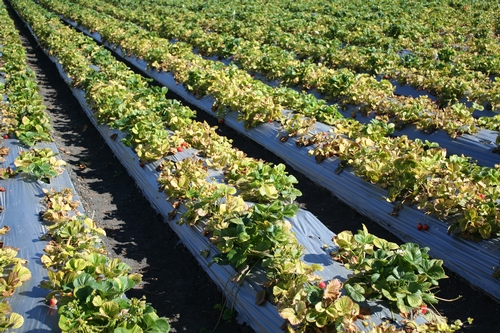
View of the situation. Yellow plants scattered among healthy green plants. Note healthy green plant in the middle of a lot of yellow ones in the bottom center of the photograph.
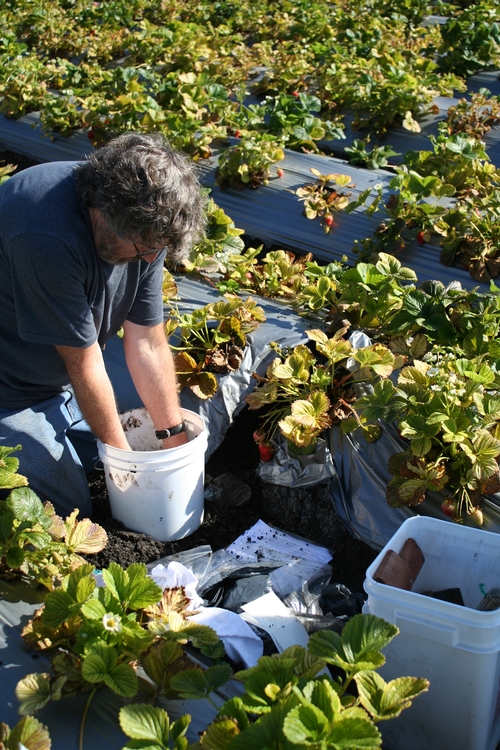
Frank Shields from Soil Control Lab sampling soil and plants.

Tissue Analysis of Yellow Plant Courtesy of Soil Control Lab
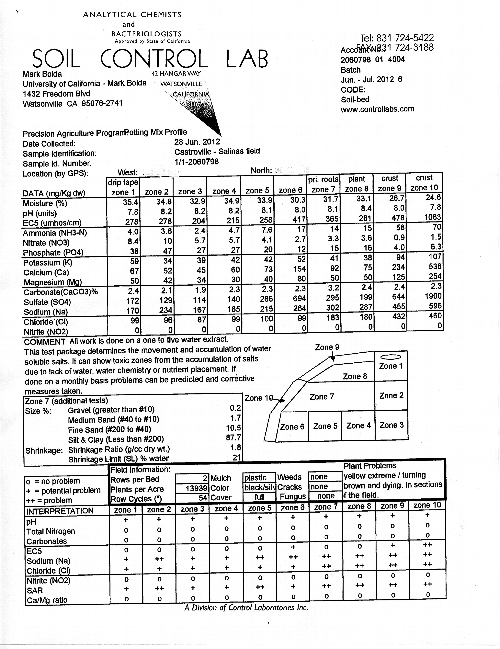
Soil Evaluation Courtesy Soil Control Lab. The diagram to the center right is a cross section of half a bed, divided into ten parts.
Leaf Purpling on Red Raspberry
Here is an interesting case regarding a slight purpling of the newer leaves of raspberry. While the case below involves ‘Polka’ variety red raspberry, I’ve seen it this year on ‘Josephine’ red raspberry in a different field as well.
The question posed is whether this purpling is meaningful from a plant health standpoint. Will this problem get worse and detract from yield and cause problems with next years crop?
For starters, there is are no disease symptoms, for example necrotic spots or goo seeping out out of the leaves or stems, nor are there any signs of disease, such as spores or conidial structures visible.
We should consider also possible side effects of insecticide or fungicide sprays. I do recall once in a trial on the strawberry variety ‘Diamante’ that repeated applications of a strobilurin fungicide such as Pristine or Quadris resulted in a similar pattern of purpling on the leaves. However in this case on ‘Polka’, the PCA in charge of this field confirmed with me that Pristine had been applied after the symptoms appeared, and this is only one application of the material. There was only one other pesticide application previous to this one, and it was more than a month ago.
What about nutrient deficiency? A simple application of what we know from nutrient deficiency books would inform us that the purpling we see here refers to some sort of phosphorous deficiency, but other nutrients can cause this too. Furthermore, those having more than a passing knowledge of the agricultural soils in the Pajaro and Salinas valleys know they are rarely phosphorous deficient, and more often than not actually have an excess of this nutrient.
Which brings us to nitrogen. Nitrogen, while commonly associated with yellowing rather than purpling of leaves, leaches out of the soil easily and as such can be deficient even in the rich soils of the California central coast. As we know, nitrogen deficiencies can be manifested in plants as a reddening or purpling of the leaves stemming from an accumulation of the same carbohydrates resulting from phosphorous deficiency.
The only way we are going to know if the above has any truth to it at all however is to take some leaf samples. The chart below is from a bulk sample consisting of at least twenty leaves, each taken from around the fifth leaf of the plant (note that this is a bit younger than the seventh leaf common for sampling, but the purpling was only found at this stage and younger).
Samples were analyzed by the Soil Control Lab in Watsonville.
|
Nutrient |
Purple leaves |
Green leaves |
|
Total Nitrogen |
2.4% |
2.6% |
|
Total Phosphorous |
0.28% |
0.29% |
|
Total Potassium |
1.3% |
1.1% |
|
Calcium |
1.3% |
1.8% |
|
Magnesium |
0.53% |
0.65% |
|
Total Sulfur |
0.2% |
0.2% |
|
Copper |
6.1ppm |
7.5 ppm |
|
Zinc |
26 ppm |
26 ppm |
|
Iron |
220 ppm |
260 ppm |
|
Manganese |
210 ppm |
190 ppm |
|
Boron |
46 ppm |
60 ppm |
|
Molybdenum |
3.6 ppm |
5.4 ppm |
The chart above shows us that for one there are no dramatic differences between in nutrient concentrations of green leaves compared to those which are purple. On the other hand, concentrations of nitrogen, phosphorous and potassium are trending just a tad low, with perhaps the nitrogen being the most significant especially since the sampled leaves were on the young side.

Foliar purpling of 'Polka' variety red raspberry
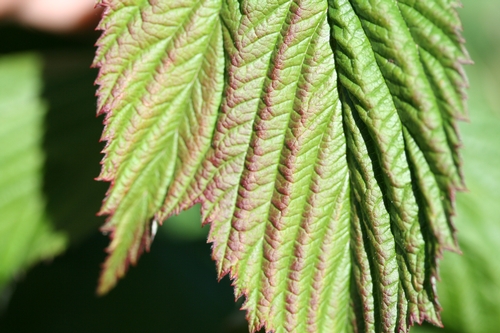
Foliar purpling of 'Polka' variety red raspberry
Finding California Oakworm Moth in Local Berry Fields
Just a real quick note here. Got a useful inquiry yesterday regarding the presence of the moth depicted below in a local berry field.
The moth in question is California oakworm, Phyrganidia californica, the larvae of which feed strictly on oaks. It is harmless to berries. It does seem though this year we have an exceptionally large number of them around and you may be finding them flying around the field or resting on plants, especially if your field is next to oaks.
Additionally, the California oakworm larva (depicted in picture # 2 below), although it would be rare to find one in a berry field, looks nothing like light brown apple moth or any other pestiferous larvae we would commonly expect in caneberries or strawberries.

California oakworm adult moths. These are harmless to berries.
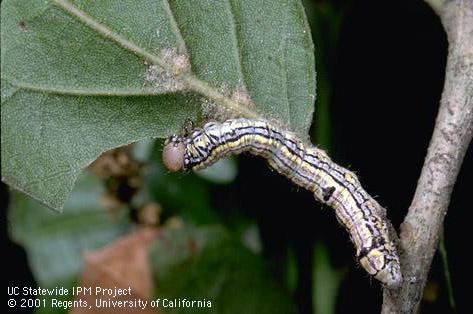
California oakworm larva.
Zeal (etoxazole) Registered for Use in Caneberries
Zeal (etoxazole) is now registered for control of phytophagous mites in caneberries. Zeal is a very welcome addition to our limited suite of miticides in caneberries. Link to the label is here:
http://www.cdms.net/LDat/ld7DK007.pdf
Had lunch at the Nickel with Tom Dewitt from Valent to get some clarification on the use of this material. Our conversation was as follows:
Breadth of Control: Zeal controls phytophagous mites in the Tetranychid family very well, so this includes both twospotted spider mites and Lewis mites. It does not kill eriophyid mites such as redberry mite nor tarsonemid mites such as cyclamen mite. As a translaminar material, it doesn't matter that the residue doesn't stick around that long on the leaf surface, since plant feeding mites will still pick it up when they penetrate the leaves to feed. It is important then also to not apply Zeal with surfactants that are stickers because they will impede the translaminar activity and instead to go with a good nonionic surfactant.
Activity on Predatory Mites: Zeal should not be applied on top of a population of predatory P. persimilis mites since it renders the males sterile and the population will cease to grow. It is recommended to hold off on releasing predatory mites until 30 days after an application of Zeal so as not to impede with their activity.
MRL's: Growers and shippers please take note that while Zeal now has a MRL (maximum residue limit) for Canada in strawberries, it does not have an MRL yet in caneberries.
I discuss the use of a miticide in this article. As always, before using this of product, check with your local Agricultural Commissioner's Office and absolutely consult the product label for product registration, restrictions, and use information.

